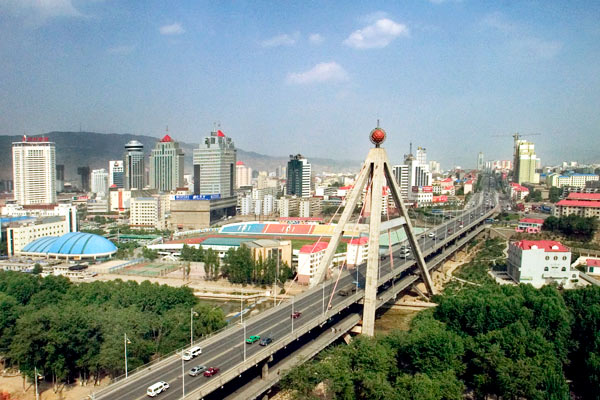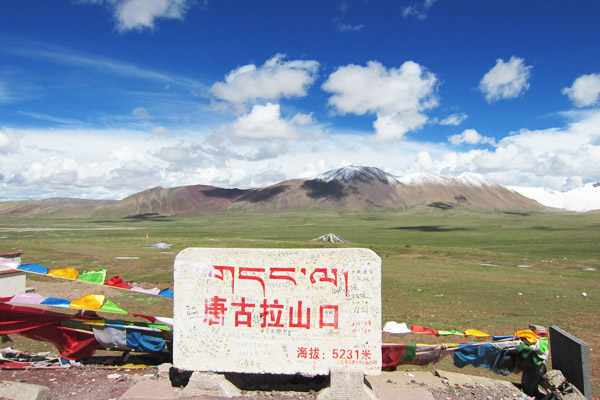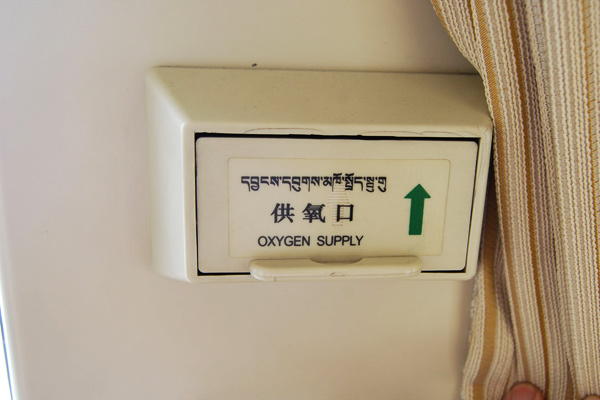Qinghai-Tibet Railway Altitude: Altitude Change and High Altitude Sickness on Tibet Train
With its location in the region covering much of the Tibetan Plateau in inner Asia, Tibet has attracted numerous tourists around the world, and miraculously, most of them are residents in low-lying areas.
So knowing the altitude change fairly well of the Tibet train in mind can greatly help you not get surprised when mild altitude symptom appears on the train from Xining to Lhasa, and can also help you make preparations for preventing from them.
Qinghai-Tibet Railway Altitude Change: Changing Points along the Route
To get a better recognition of the altitude change along the Qinghai-Tibet Railway and enjoy the best Tibet tour with Tibet train experience, the best way is to find the representative places which can show an obvious altitude change.
Along the entire train trip to Lhasa, there are mainly 5 remarkable altitude changing points and they are: Xining station, Golmud station, Kunlun Mountain Pass, Tanggula Mountain Pass, and Lhasa station.
Altitude Change at Xining Station (2,275 m)
As the starting point of Qinghai-Tibet train, Xining is a place from which you really get your train heading for Lhasa started. No matter wherever you board the train in Beijing, Shanghai, Chengdu, Guangzhou, etc. you will finally arrive at this station and continues your trip to Lhasa by following the only railway route to Tibet.
 Xining city at a lower altitude of less than 24,00 meters
Xining city at a lower altitude of less than 24,00 meters The altitude of Xining station is merely about 2,275 meters and there seldom have passengers suffering from high altitude sickness here, even if some of the passengers coming from low-altitude areas.
Tips:
1.) The train will take a contemporary stop at Xining station for 20 minutes. Grasp the chance to get off the train and fell the first breath of the Qinghai-Tibet Plateau. Though the altitude is low, try not to carry out intense physical activities and return to your cabin ahead of the train departing time.
2.) Leaving Xining station, the landscapes are totally changed with the views outside the window turning to be stretching and breathtaking. You can overlook China’s largest inland and saltwater lake, Qinghai Lake, when the train passes by the north bank of it.
3.) You can appreciate Qinghai Lake scenery by boarding trains with its starting station from Beijing, Chengdu, Chongqing, Lanzhou and Xining respectively, for it is daytime when the train passes by the Lake.
Altitude Change at Golmud Station (2,809 m)
Leaving Xining station, the train begins its first climb from 2,275 meters to 2,809 meters when it arrives at Golmud station after approximately 7 short hours. However, in spite that the elevation increases a lot, most of the passengers can still not feel any uncomfortableness causing by the high altitude sickness.
Tips:
1.) The train will make a short stop at Golmud station for 25 minutes. Why not step off the train and look around. Indulge yourself with the infiltration of the fresh air for a couple of minutes and don’t forget to go back to your cabin before the train is departing.
2.) Sceneries from Golmud to Lhasa are generally accepted as the most beautiful ones along the entire trip. Keep your eyes open to witness the view change outside the window from basins to snowy mountains, from gobi desert to highland grasslands, from alpine mountains to the high altitude lakes. You can experience all the miracle changes when the train is heading for Tibet from Golmud.
3.) The train is moving forward with continuously rising altitude.
Altitude Change at Kunlun Mountain Pass (4,700 m)
While Kunlun Mountain Pass may not be the highest point of the Qinghai-Tibet Railway, it is the end of the sharpest and steepest increase in altitude of the entire trip. Kunlun Mountain Pass sits at an altitude of 4,700 meters above sea level and has an elevation difference of 1,891 meters from Golmud, where the steep incline started.
 Kunlun Mountain Pass
Kunlun Mountain Pass It is a short journey of just a few hours before the train arrives at Kunlun Mountain Pass. The train ascends you very quickly to this high elevation and reaches the third remarkable altitude point before leveling out and make a slightly drop to continue the journey to the next high point, the highest on the Qingzang Railway, Tanggula Pass.
Tips:
1.) The sharp rise in elevation from Golmud station to Kunlun Mountain Pass makes the air in the train become thinner with comparatively low oxygen content, so some passengers may have mild symptoms of high altitude sickness.
2.) This may not seem like much, however, when you take into account that experts recommend ascending at no more than 300 meters per day after the first 3,000 meters, this climb from Xining to Kunlun, which takes less than 12 hours, is more than a little extreme. The expert recommendation is that there should be a rest period of at least 24 hours after each ascent of 1,000 meters.
However, this is not possible when traveling on the train and with the sharp increase in elevation in the first half-day of the trip, there is a higher likelihood of feeling some mild effects of high altitude sickness at this point. This can often lead to a rough night’s sleep because respiration decreases during sleep, which can exacerbate the symptoms of high altitude sickness.
3.) Don’t get too upset about the high altitude sickness onboard, for as the most comfortable train to Tibet, there have two kinds of oxygen supply system mounted on the train, which will pump the oxygen to the air from Golmud to Lhasa.
Altitude Change at Tanggula Pass (5,072 m)
The train regains its momentum to head for Tanggula station after a slight drop when it left the Kunlun Mountain Pass. As the world’s highest train station, Tanggula station sits on the provincial boundaries at the elevation of 5,072 meters. The train passes prairies and the Hoh Xil Nature Reserve before it gets to Tanggula Pass.
 Tanggula Mountain Pass
Tanggula Mountain PassTips:
1.) Tibet train will not make a stop at Tanggula Pass, so it flashes quickly in front of your eyes. You may possibly have passed it without noticing. So the only way to know whether you are approaching the highest point or not is to use the altitude indicator on the train.
2.) Don’t get too upset or too excited when the train is passing the highest place during the entire trip. Drink a lot of water and maintain the peace of mind. The constantly pumping of oxygen in the train coaches will help you to a great extent soothe the uncomfortableness caused by the sharp altitude change.
3.) Use oxygen supply outlet if passengers feel uncomfortable with high altitude sickness the increased oxygen content in the train.
Altitude Change at Lhasa (3,650 m)
From Tanggula Pass, the train begins its gradual descent following the route to Lhasa, where it ends at the elevation of 3,490 meters.
Tips:
With the train approaching Lhasa station, you can find yaks and sheep flocking on the grasslands. The Tibet characteristic architectures are caught your eyes. The drop in altitude does not mean your mild high altitude sickness will disappear immediately. Failed to soothe or relieve the sickness can make it even worse. So, when you arrive at Lhasa, try to stay at hotel or take a good rest before going outside.
Tibet High Altitude Sickness: Symptoms and How to Treat
With a higher chance of suffering from high altitude sickness during the steep climb to Kunlun Pass, you should know how to recognize the symptoms of them, in case you experience it.
What are Symptoms of Tibet High Altitude Sickness?
The onset of mild high altitude sickness includes:
Headache
Dizziness
Fatigue
Shortness of breath
Loss of appetite
Nausea
Disturbed sleep
General feeling of malaise
How to Treat Tibet High Altitude Sickness on Tibet Train?
The physical condition differs from one another, so different people may suffer from different altitude symptoms. On Qinghai-Tibet train, there are mainly two oxygen supply systems provided for passengers to deal with the high altitude sickness.
System of bumping the oxygen into the train
The Oxygen is automatically pumped into the train when it reaches the higher altitudes above Golmud, which raises the concentration in the air from 21% to around 25%. This increase in oxygen levels creates a condition equivalent to that of Lhasa during the higher altitude parts of the journey.
 Oxygen Supply Outlet
Oxygen Supply OutletHowever, this is still a much higher altitude than that in Xining, where the train started, and where many passengers would have become acclimatized to that elevation.
Outlets positioned in the soft sleeper cabins and along the corridors
For those suffering from the mild symptoms of high altitude sickness while the train is en route to Lhasa, there are also oxygen tubes available from the train staff, which can be plugged into outlets positioned in the soft sleeper cabins and along the corridors of the train.
This extra infusion of oxygen can help to relieve the mild symptoms of high altitude sickness for a brief period, but should not be used continuously throughout the trip, as it will make acclimatization much harder once you reach Lhasa.
Ask for help from the train staff
Make sure that you let someone on the train know that the symptoms are present. All of the staff are well versed in the symptoms of high altitude sickness, and all of the trains have medical staff on standby for any occurrences.
The medical staff is well trained in treating high altitude sickness, and can help to keep the more serious symptoms at bay while your body acclimatizes to the higher altitudes. In any emergency, where the symptoms get worse, seek medical help from the nurses of doctor on board the train. The medical unit is normally situated next to the dining car.
There is no foolproof way to avoid getting high altitude sickness, as everyone has a different response to high altitudes. However, the majority of visitors can avoid getting sick by ascending slowly once over 2,500 meters above sea level.
Tips:
A good way to help prevent high altitude sickness when traveling to Tibet by train is to spend a few days at a lower altitude that is not above 2,400 meters. Xining, at 2,275 meters above sea level, is ideal for acclimatization, and as long as you are careful and able to recognize the symptoms if they attack on the train, you should be able to get through with no problems at all.
Conclusion
Altitude along the Qinghai-Tibet Train varies constantly and reaches to a high point at Tanggula station, the world’s highest railway station with the altitude of 5,072 meters.
The climb from Golmud station to Kunlun Mountain Pass is the sharpest and steepest increase in altitude of the entire trip.
There are totally five iconic places for the elevation change: Xining station (2,275 m), Golmud station (2,809 m), Kunlun Mountain Pass (4,700 m), Tanggula Pass (5,072 m), and Lhasa station (3,650 m).
While there is no way to guarantee that you will not get high altitude sickness, there are many ways to protect yourself from the more serious outcomes, which only happen rarely.
Knowing the early signs of high altitude sickness and being willing to acknowledge that they are present, is half of the battle. Mild high altitude sickness is more common than you would think, and is generally not debilitating if taken seriously.
Once you have recognized that you or someone in your party has the symptoms, it is important not to ascend to a higher elevation, and it is recommended to descend to an altitude where the symptoms disappear or decline. Since Kunlun is the extreme part of the climb, and the rest of the journey is relatively level, before actually dropping on the route into Lhasa, this can help with the treatment.
 BACK
BACK
0 Comment ON "Qinghai-Tibet Railway Altitude: Altitude Change and High Altitude Sickness on Tibet Train"